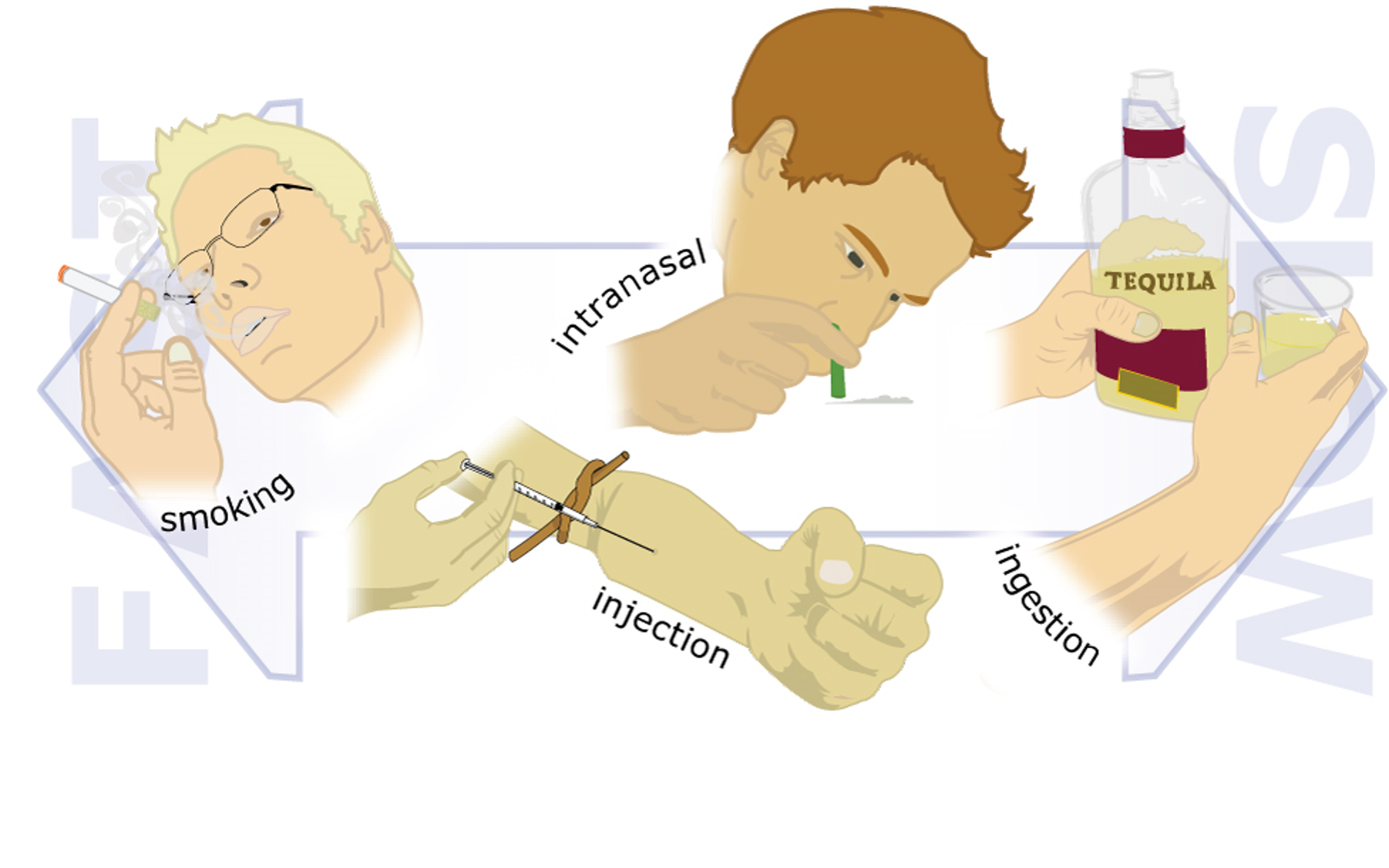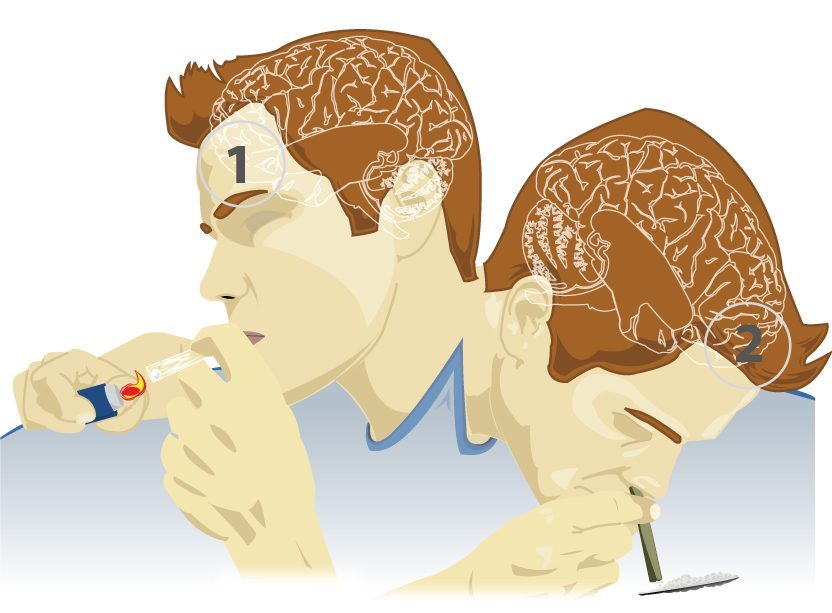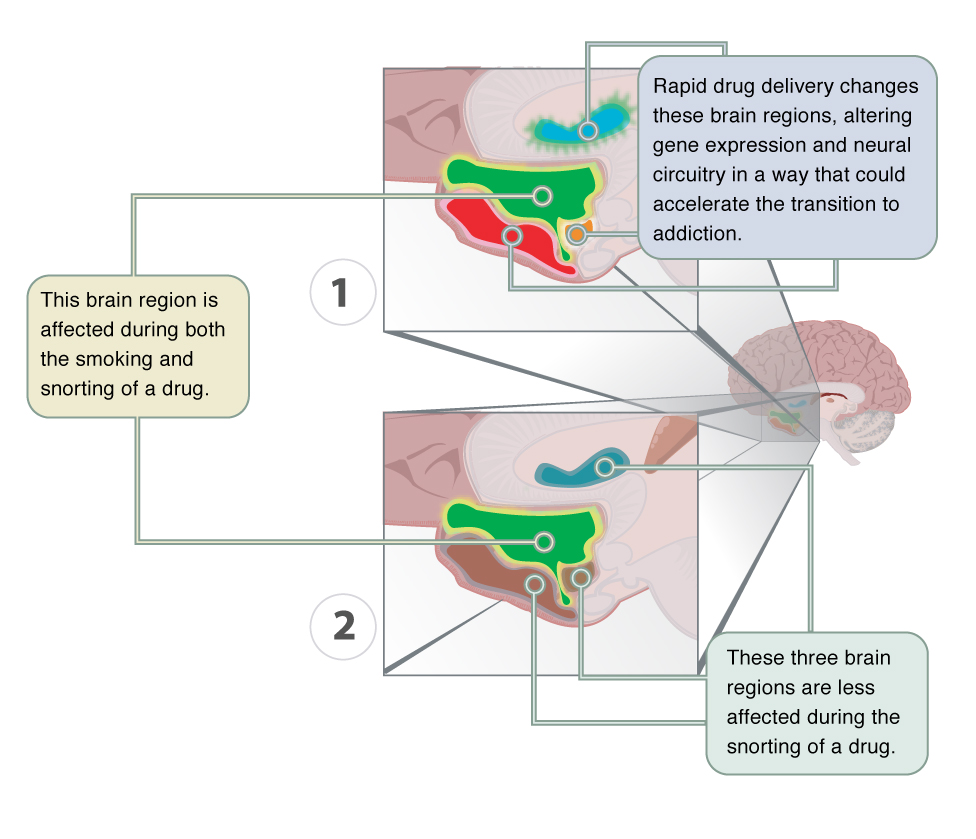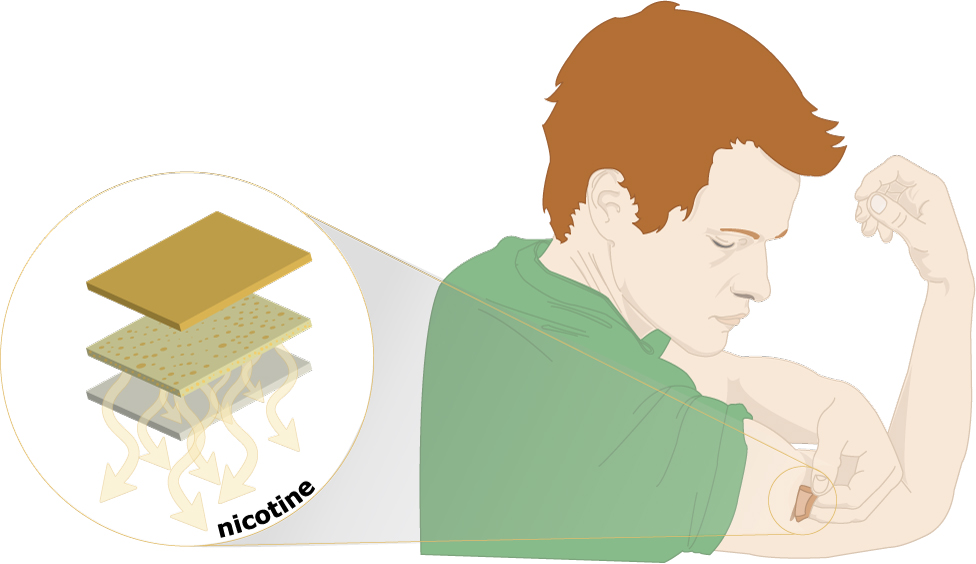4.2 Routes of administration
Research has shown that the faster a substance reaches the brain, the more likely it may become misused. Different methods of delivery—smoking, injecting, or snorting—largely influence how quickly a substance reaches the brain. Delivery methods, genetics, and environment all influence the potential of a substance to develop into a substance use disorder.

4.2A Activities
- Brainstorm a list of all the ways that a person can get a substance into their body?
- Rate your list; which way do you think is fastest? Which way is slowest?
When a person injects a substance into their vein or smokes and inhales into their lungs, they feel the effects of the substance very quickly. Snorting a substance into a nasal cavity or swallowing a substance means it takes longer for the body to absorb and feel the effects; the drugs uptake is slower.[1] People can take a substance in a number of ways. The routes of administration are described in the table below.[2]
| Method | Example of Drug | Time Needed for Effect | Advantages of Route | Disadvantages of Route |
| Oral | Alcohol | 30-60 minutes | Convenient | Slow, irregular |
| Inhalation | Nicotine | 8 seconds | Fast | Lung damage |
| Intravenous Injection | Heroin | 15 seconds | Fast | Overdose/ infections |
| Mucous membrane | Cocaine | 1-2 minutes | Convenient | Local tissue damage |
| Subcutaneous injection | Heroin | 5-10 minutes | Safer & easier than IV | Infection |
| Intramuscular Injection | Morphine | 10-15 minutes | Controlled | Painful |
| Transdermal | Nicotine | 15-20 minutes | Convenient | Limited application/ potential misuse |
Fast Delivery

The fastest way to get a substance to the brain is by smoking it. When a substance like tobacco smoke for instance is taken into the lungs, nicotine seeps into lung blood where it can quickly travel to the brain. This fast delivery is one reason smoking cigarettes is can turn into a disorder quickly.
Injecting directly into a blood vessel is the second fastest way to get a substance to the brain, followed by snorting or sniffing it through the nose. A slow mode of delivery is ingestion, such as drinking alcohol. The effects of alcohol take many minutes rather than a few seconds to cause behavioral and biological changes in the brain.
Rapid Delivery Changes Your Brain

People who have a substance use disorder often choose a delivery method that gets them high quickly. As the SUD progresses, people will seek out the more immediate and more intense high. But speed does not seem to be the only reason that rapid delivery is an important factor. Recent evidence suggests that the mode of delivery can actually influence which part of the brain is most affected by a substance. Rapid delivery, such as smoking, affects brain regions that facilitate substance use disorders.
Slow Delivery

Increased knowledge about substance delivery methods is leading to new therapies to support substance use disorders. For example, delivering a substance slowly, by ingestion or through the skin, produces a weaker, longer-lasting effect. You may have seen nicotine patches for people who have tobacco use disorder. Slow delivery allows the substance to temporarily stabilize the brain and help reduce withdrawal symptoms over a longer period of time. Research suggests a slower delivery method can reduce the risk of an addiction.[3]
Drug Administration[4]
Drug administration is the giving of a drug by one of several means (routes).
| Route | Explanation |
| buccal | held inside the cheek |
| enteral | delivered directly into the stomach or intestine (with a G-tube or J-tube) |
| inhalable | breathed in through a tube or mask |
| infused | injected into a vein with an IV line and slowly dripped in over time |
| intramuscular | injected into muscle with a syringe |
| intrathecal | injected into your spine |
| intravenous | injected into a vein or into an IV line |
| nasal | given into the nose by spray or pump |
| ophthalmic | given into the eye by drops, gel, or ointment |
| oral | swallowed by mouth as a tablet, capsule, lozenge, or liquid |
| otic | given by drops into the ear |
| rectal | inserted into the rectum |
| subcutaneous | injected just under the skin |
| sublingual | held under the tongue |
| topical | applied to the skin |
| transdermal | given through a patch placed on the skin |
| vaginal | inserted into the vagina |
Chapter Credit
Adapted from Unit 2.1 in Drugs, Health & Behavior by Jacqueline Schwab. CC BY-NC-SA.
Image Credits
Genetic Science Learning Center. (2013, August 30) Drug Delivery Methods. https://learn.genetics.utah.edu/content/addiction/delivery/
- Samaha, A-N., & Robinson T. E. (2005). Why does the rapid delivery of drugs to the brain promote addiction? Trends in Pharmacological Sciences, 26(2), 82-87. https://pubmed.ncbi.nlm.nih.gov/15681025/ ↵
- Case-Lo, C. (2019, March 28). Medication administration: Why it’s important to take drugs the right way. https://www.healthline.com/health/administration-of-medication ↵
- Genetic Science Learning Center. (2013, August 30). Drug delivery methods. https://learn.genetics.utah.edu/content/addiction/delivery/ ↵
- Le, J.(2012, October 12). Introduction to administration and Kinetics of Drugs. Merck Manual Consumer Version. https://www.merckmanuals.com/home/drugs/administration-and-kinetics-of-drugs/introduction-to-administration-and-kinetics-of-drugs ↵

